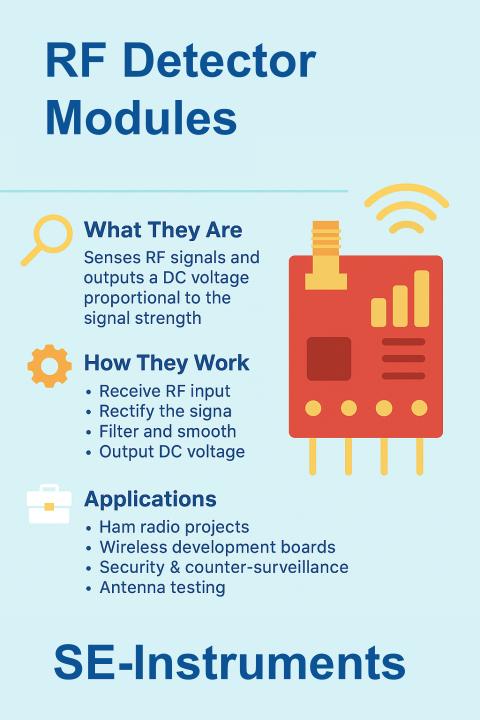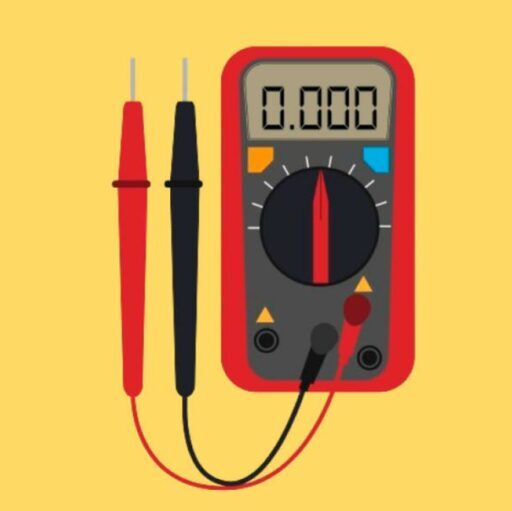📡 RF (Radio Frequency) detector modules are small but powerful components widely used in wireless systems for detecting the presence, strength, or envelope of radio signals. Whether you’re working on a DIY RF project, a security application, or signal monitoring, RF detector modules offer a simple way to gain RF awareness in your circuit.
Let’s explore what they are, how they work, where they’re used, and which ones are worth considering.
Table of Contents
🔍 What Is an RF Detector Module?
An RF detector module is an electronic circuit or component that senses RF signals and converts them into a measurable output – typically a DC voltage that is proportional to the strength (amplitude) of the RF signal.
They are designed to operate over a range of frequencies (MHz to GHz) and are often used in:
- Signal strength indication
- RF power monitoring
- Spectrum sensing
- Hidden transmitter detection
- Antenna tuning systems

⚙️ How Does an RF Detector Module Work?
RF detector modules typically consist of:
- A diode detector (often Schottky) that rectifies RF signals
- A low-pass filter to smooth out the signal into DC
- A buffer/amplifier to condition the output
Here’s the general workflow:
- Receive RF input from an antenna or circuit.
- Rectify the signal using a high-speed diode.
- Filter and smooth it to generate a voltage proportional to signal strength.
- Output the DC voltage for monitoring or control.
Some advanced detector modules use logarithmic detection for wide dynamic range, especially useful in power monitoring and RF measurement instruments.
🧰 Common Applications of RF Detector Modules
RF detector modules are used in both hobbyist and commercial applications, such as:
- 📻 Ham Radio Projects – monitor transmitted power and reflected signal levels
- 🛠️ Wireless Development Boards – integrate RF awareness in embedded systems
- 🔒 Security & Counter-Surveillance – detect hidden transmitters or bugs
- 📶 Antenna Testing – measure radiation pattern or match
- 📡 Signal Trackers – used in drones or RF signal mapping
🏆 Recommended RF Detector Modules
Here are some highly-rated RF detector modules available today:
| Module | Frequency Range | Output Type | Key Features |
|---|---|---|---|
| AD8318 Module | 1 MHz – 8 GHz | Logarithmic DC | Wideband, stable, precise |
| AD8307 Module | DC – 500 MHz | Logarithmic DC | Ideal for HF/VHF measurements |
| RF-Detector 100MHz–2.4GHz | 100 MHz – 2.4 GHz | Linear DC | Basic bug detector use |
| Mini RF Power Meter (DIY Kit) | 100 MHz – 2.5 GHz | Display & DC | Easy-to-use, beginner-friendly |
💡 Tip: Choose a detector with a frequency range that matches your application. For example, the AD8318 is great for SDR and 2.4 GHz Wi-Fi monitoring.
🔧 How to Use One
Using an RF detector module is usually straightforward:
- Connect the RF input to your antenna or signal source.
- Connect power (VCC & GND) to the module (typically 5V).
- Read the output voltage using a multimeter, ADC, or microcontroller.
Advanced setups may include calibration to interpret dBm values accurately.
✅ Final Thoughts
RF detector modules are incredibly useful tools for hobbyists, engineers, and security professionals. They let you sense the invisible world of RF signals without needing expensive equipment. Whether you’re debugging a wireless system or building a bug sweeper, there’s an RF detector module for your needs.




